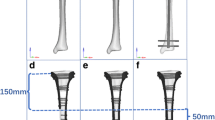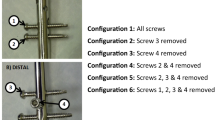Abstract
Background
Fractures of the proximal tibia occur very often and are a great challenge for trauma surgeons to stabilize. Although locked nails were developed to stabilize these fractures, this technique has not been sufficiently investigated. The purpose of this study was to biomechanically assess the stability of locked intramedullary nailing compared to locked plating.
Methods
16 fresh frozen human cadaveric tibiae were osteotomized in the meta-diaphyseal intersection with an osteotomy gap of 10 mm and a single osteotomy through the medial epicondyle to simulate a 41-C.2 fracture. Stabilization was performed with an angle stable locked Targon-TX nail (n = 8) and two additional canulated screws. The other testing group (n = 8) was treated with two canulated screws and a five-hole LCP-PLT. The bones were tested in a cyclic testing protocol with increasing loads under compression and a load sharing of 60 % through the medial tibial plateau and 40 % to the lateral side. Stiffness and fracture gap movement were measured and failure mode was assessed.
Results
No significant differences were found between the two implants regarding load until failure. The stiffness of the intramedullary nailing group (927 N/mm) was statistically significantly higher than the stiffness of the plating group (564 N/mm). No differences were found for fracture gap movement in the z-axis. However, differences were found for dislocation of the proximal-lateral and proximal-medial fragments, with absolute values of 0.099 mm in the plate group and 0.66 mm in the nailing group at 800 N. Prior to failure, fracture gap movement was 0.22 mm for the plating group and 1.66 mm for the nailing group, a difference that was also statistically significantly different. The nailing group failed by screw cut-out while the plating group failed by screw breakage.
Conclusion
Nailing of proximal tibia fractures leads to a stiffer implant-bone construct than plating. Since no adverse effects were found after nailing it seems to be a good alternative to plating for intra-articular proximal tibia fractures, especially in patients with soft tissue problems.





Similar content being viewed by others
References
Cole JD (1998) Intramedullary fixation of proximal tibia fractures. Tech Orthop 13:27–37
Dendrinos GK, Kontos S, Katsenis D et al (1996) Treatment of high-energy tibial plateau fractures by the Ilizarov circular fixator. J Bone Joint Surg Br 78:710–717
Lang GJ, Cohen BE, Bosse MJ et al (1995) Proximal third tibia fractures. Should they be nailed? Clin Orthop Relat Res 315:64–74
Hansen M, Blum J, Mehler D et al (2002) Intramedullary osteosynthesis of metadiaphyseal proximal tibial fractures: an optimized implant geometry can help to solve the problem. Osteosynth Trauma Care 10:188–191
Buehler KC, Green J, Woll TS, Duwelius PJ (1997) A technique for intramedullary nailing of proximal third tibia fractures. J Orthop Trauma 11:218–223
Schandelmeier P, Krettek C, Rudolf J et al (1997) Superior results of tibial rodding versus external fixation in grade 3B fractures. Clin Orthop 342:164–172
Haidukewych G, Sems SA, Huebner D, Horwitz D, Levy B (2007) Results of polyaxial locked-plate fixation of periarticular fractures of the knee. J Bone Joint Surg Am 89(3):614–620
Nikolaou VS, Tan HB, Haidukewych G, Kanakaris N, Giannoudis PV (2011) Proximal tibial fractures: early experience using polyaxial locking-plate technology. Int Orthop 35(8):1215–1221
Lembcke O, Rüter A, Beck A (2001) The nail-insertion point in unreamed tibial nailing and its influence on the axial malalignement in proximal tibial fractures. Arch Orthop Trauma Surg 121:197–200
Konrad G, Südkamp N (2007) Proximale extraartikuläre Tibiafraktur. Chirurg 78(161):175
Mueller CA, Eingartner C, Schreitmueller E et al (2005) Primary stability of various forms of osteosynthesis in the treatment of the proximal tibia. J Bone Joint Surg Br 87:426–432
Hansen M, Mehler D, Hessmann MH et al (2007) Intramedullary stabilization of extraarticular proximal tibial fractures: a biomechanical comparison of intramedullary and extramedullary implants including a new proximal tibia nail (PTN). J Orthop Trauma 21:701–709
Morrison JB (1970) The mechanics of the knee joint in relation to normal walking. J Biomech 3:51–61
Jiang R, Luo CF, Zeng BF (2008) Biomechanical evaluation of different fixation methods for fracture dislocation involving the proximal tibia. Clin Biomech 23:1059–1064
Brown SJ, Pollintine P, Powell DE, Davie MW, Sharp CA (2002) Regional differences in mechanical and material properties of femoral head cancellous bone in health and osteoarthritis. Calcif Tissue Int 71:227–234
Sommers MB, Fitzpatrick DC, Madey SM, Vande Zanderschlup C, Bottlang M (2007) A surrogate long-bone model with osteoporotic material properties for biomechanical testing of fracture implants. J Biomech 40:3297–3304
Hansen M, Blum J, Mehler D, Hessmann MH, Rommens PM (2009) Double or triple interlocking when nailing proximal tibial fractures? A biomechanical investigation. Arch Orthop Trauma Surg 129:1715–1719
Laflamme GY, Heimlich D, Stephen D, Kreder HJ, Whyne CM (2003) Proximal fracture stability with intramedullary nail fixation using oblique interlocking screws. J Orthop Trauma 17(7):496–502
D’Lima DD, Patil S, Steklov N, Slamin JE, Colwell CW (2006) Tibial forces measured in vivo after total knee arthroplasty. J Arthroplasty 21(2):255–262
Gollwitzer H, Karampour K, Hauschild M, Diehl P, Busch R, Mittelmeier W (2004) Biomechanical investigation of the primary stability of intramedullary compression nails in the proximal tibia: experimental study using interlocking screws in cryopreserved human tibias. J Orthop Sci 9(1):22–28
Lindvall E, Sanders R, Dipasquale T, Herscovici D, Haidukewych G, Sagi C (2009) Intramedullary nailing versus percutaneous locked plating of extra-articular proximal tibial fractures: comparison of 56 cases. J Orthop Trauma 23(7):485–492
Hansen M, El Attal R, Blum J, Blauth M, Rommens PM (2009) Intramedullary nailing of the tibia with the expert tibia nail. Oper Orthop Traumatol 21(6):620–635
Acknowledgments
This study was sponsored by Aesculap. No influence on the results was taken by the industrial partners. We would like to thank Kevin Burfeind for his translational work as an American native speaker.
Author information
Authors and Affiliations
Corresponding author
Rights and permissions
About this article
Cite this article
Högel, F., Hoffmann, S., Panzer, S. et al. Biomechanical comparison of intramedullar versus extramedullar stabilization of intra-articular tibial plateau fractures. Arch Orthop Trauma Surg 133, 59–64 (2013). https://doi.org/10.1007/s00402-012-1629-x
Received:
Published:
Issue Date:
DOI: https://doi.org/10.1007/s00402-012-1629-x




